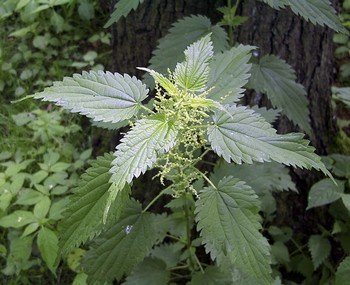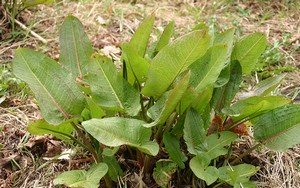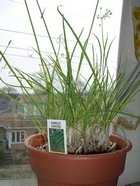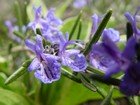Stinging Nettles Uses and Benefits in Nettle Tea, Beer, Juice and Chicken Feed
Common nettles grow on ditch-banks, and among rubbish, and although there are around 500 varieties of nettles around the world, it is the stinging nettle that is of interest here. It flowers in the month of July in the northern hemisphere. This species has a square, firm stem, three or four feet high, with long-pointed, serrated leaves, that come with stings which, on being touched, causes a burning and painful sensation. In Italy, you can see grandmothers stooped in fields in spring harvesting young nettle leaves to use in her cooking later that day, and nettles can even be found on dishes served in the fanciest of Italian restaurants. People in Europe have known the value of nettles for centuries and it has been part of their spring diet because of its excellent cleansing properties.
Nettles will quite happily grow on in most gardens, backyards and fields. And if you see a large field of nettles on your property the soil beneath will be rich in nitrogen, as the presence of nettles normally indicates this. So many people want to rid their fields and gardens of nettles, but why? They have so many benefits!
Eating Stinging Nettles
Picture courtesy of Uwe H. Friese, Bremerhaven 2003 Stinging
Nettles are generally considered as a noxious weed but it has many
benefits and uses.
Stinging
Nettles are generally considered as a noxious weed but it has many
benefits and uses.
Its young tops may be boiled during the spring and summer, and eaten as a substitute for greens. However, in late summer and autumn they are not good to eat as the leaves are not tender at this stage. In the spring take young nettle tops and cut finely.
They are extremely nourishing, but don't eat too many as it acts as a mild laxative. Stinging Nettles have a flavor similar to spinach when cooked and is rich in vitamins A, C, D, iron, potassium, manganese, and calcium.
Instead of using salt and pepper in your cooking you can substitute these seasonings with nettle. Small quantities of dried nettle can be used to flavor most dishes. Because of the natural salts and minerals in nettle they are an invaluable seasoning for diabetics and people on a salt-free diet.
By soaking stinging nettles in water or by cooking them will remove the stinging chemicals from the plant, which allows them to be handled and eaten without incidence of stinging. The sting of the nettle is also removed when the plant is dried. You can eat nettles raw when the plants are very young and appear in the spring. Add a dressing of olive oil (2 tablespoons) and some lemon juice (1 tablespoon). You can also add them to lettuce, or with dandelion leaves and sorrel as a spring salad, or just on their own.
You can improve the nettles by serving them with some melted butter, or by making a thick white sauce as you would for creamed spinach. Nettles can be used in a variety of recipes, such as soups, polenta and pesto. Nettle soup is a common use of the plant, particularly in Northern and Eastern Europe.
Here is a Nettle Soup Recipe
3 oz young nettle leaves1 tablespoon butter
1 onion, diced
3/4 lb. potato, diced small
2 pints chicken stock
1 teaspoon mixed fresh sage, marjoram and basil
2 tablespoons cream
Wash nettle leaves well and drain. Place in a saucepan with a little water. Cook until tender. This only takes a minute or two. Allow to cool and then chop up.
Saute the onion and potato in butter over a low heat till golden. Add more butter if needed. Add the stock.
Simmer till cooked, add nettles and other herbs. Simmer again for about 15 minutes and allow to stand in a warm place for a while. Blend in the milk or cream and serve dotted with butter and grated cheese.
Stinging Nettles and Cheese Making
In the Western Islands of Scotland stinging nettles use to be used as a natural rennet for cheese making. The natural rennet recipe using nettles was prepared by adding a quart of salt to three pints of a strong decoction of nettles. 5 tablespoonfuls is enough to coagulate a bowl of milk.
Here is an old rennet recipe for using nettles in cheese:
Take two pints new milk, curdle it either by slow heat, or by rennet, lemon juice, fig juice, or bruised nettles. Turn the curd into a cheese cloth or butter muslin (coarse canvas will do), previously scalded, tie loosely and hang up to drain. After three or four hours tie again tighter. In twelve hours it is fit to eat, but if preferred it can be pressed and turned every day till as firm as ordinary cheese.
Yarg is a semi-hard cow's milk cheese made in Cornwall, United Kingdom from the milk of Friesian cows. Before being left to mature, this cheese is carefully wrapped in nettle leaves to form an edible, though moldy, rind.The nettles, though being the ingredient which gives Yarg its unique flavor, were originally used as a preservative. However, this ingredient is what now delights many, described as having "a delicate, almost mushroom flavor." As well as the taste of the nettles, an interesting flavor is added by the mold allowed to grow on the cheese, which is not harmful.
Drinking Stinging Nettles
Nettle cordial is a soft drink made largely from a refined sugar and water solution flavoured with the leaves of the nettle. Historically it has been popular in North Western Europe; however, versions of a nettle cordial recipe can be traced back to Roman times. It is an aromatic syrup, and when mixed with sparkling water, is very refreshing.Nettle tea is said to have very good medicinal properties. A tea made from young nettle tops is a Devonshire cure for nettlerash which you get after being stung. However, don't make it too strong, and don't drink too much of it as it can actually cause the body to come out in an additional rash.
Nettle Beer uses a large amount of young, green stinging nettles which are boiled up in a gallon of water, with the juice of two lemons for a sharp flavour, and a teaspoonful of crushed ginger. Then, for sweetening purposes, a pound of brown sugar is mixed in. Then some fresh yeast from the brewer is to be floated on toast in the liqued when cold, so as to ferment it; and it may be afterwards bottled as a specially wholesome sort of ginger-beer.
Stinging Nettles for Chickens and Livestock Feed
Nettle leaves are excellent for feeding poultry; and especially in the winter. When boiled and eaten the stinging nettles promote the laying of eggs right throughout the winter. If horses, sheep, goats, cows, and pigs are given nettles fresh they won't eat them, although donkeys and asses love them. When nettles are dried they are eaten by cows resulting in an excellent food that helps to increase the quantity and quality of their milk. It also makes their coats shine.
Sometime back I came across instructions on how to get a capon to look after chickens using nettles. I have never tried it, so I cannot tell you whether it works or not! Perhaps some of you have, and will let us know!Apparently capons can easily be taught to clutch a fresh brood of chickens: First, the fowl is tamed so that it will feed from your hand. As evening approaches pluck some feathers from his breast and rub the bare skin with some nettles, placing the chickens beneath him. This is repeated two or three nights in succession, till the capon takes to his brood. When one brood is grown up, another nearly hatched may be placed under him in the same way and he will apparently make a jolly good substitute for a hen!
Stinging Nettle Root for Dyeing
The roots of the Common Nettle, when boiled, will dye wool and cotton to a yellow tinge.Stinging Nettle Juice
Steel dipped in the juice of the nettle becomes flexible. Also, lint, dipped in nettle juice will stop a bleeding nose if applied to the nostril. Fresh nettle juice, given in doses of from 1 -2 tablespoonfuls, is said to be an old-fashioned remedy for lss of blood, whether from the nose, the lungs or some other internal organ.Stinging Nettles for Cloth
But the most valuable part, is the nettles' fibrous stalk or stem has been used in the past to make a very good cloth, similar to hemp. A coarse kind of durable canvas was also produced, which was considerably harder than the cloth manufactured from hemp or flax. Making fabric from nettles is not new; fabric woven of nettle fiber has been found in burial sites dating back to the Bronze Age.A very good white writing paper has also been made using nettles and nettle seeds were used in the past as a good oil for lamps.
Medicinal Uses for Stinging Nettles
In a medicinal view, the whole plant, and particularly the root, is said to be a diuretic.
A leaf, if placed on the tongue, and pressed against the roof of the mouth, is said to be helpful in stopping bleeding of the nose.
Nettle is used in homemade cosmetics - hair shampoos to control dandruff and is said to make hair more glossy, which is why some farmers include a handful of nettles with cattle feed. It is also thought nettles can ease eczema.
Arthritic joints were sometimes treated by whipping the joint with a branch of stinging nettles. The theory was that it stimulated the adrenals and thus reduced swelling and pain in the joint. A 2000 controlled study supports the effectiveness of this treatment. (Randall C, Randall H, Dobbs F, Hutton C, Sanders H (2000 Jun)). I cannot say that I have tried this method myself, but I can say that I received fantastic relief from drinking rosehip tea on a daily basis - but I digress!
If you plant the stinging nettle plant anywhere near places where frogs frequent, you will soon chase the frogs away. For some reason they do not like stinging nettles at all and will soon find another home to croak from.How to Harvest Stinging Nettles
Choose a fine day to go out nettle hunting. Make sure that you have a good pair of scissors and wear some gloves to protect your hands and long trousers to protect your legs. Collect the nettle plants after the morning dew has burned off. If you are only taking the young shoots, cut off the last inch of the plant. If you are harvesting the whole nettle plant cut it off a little above the root. This will allow the plant to recover over time and produce again.Drying nettle is also possible, just as can dry other herbs. Hang upside down in bunches in a room away from direct sunlight but where there is good air circulation and no damp. Rub when brittle and store in airtight containers in a dark cupboard.
If you are harvesting nettle seed these can be dried on trays or pieces of paper in the sun or near a wood stove.
Stinging Nettles and Your Garden
Because nettles are high in nitrogen and therefore are excellent, either for your compost heap after they have been pulled up, or as a liquid nitrogen fertilizer for your garden and vegetables. Nettles don't just add nitrogen to your compost heap, but they actually accelerated the breakdown of your compost heap.
To make the liquid manure, you can fill up a bucket of nettles, fill the rest up with water and allow to steep for a couple of weeks until the water is a browny color. Now you can take it an use it on the garden, but you have to dilute it 1:10.Cures for Stinging Nettle Stings
I suppose one couldn't end this article without telling you how to cure a nettle sting. If you have ever been stung by nettles you will know that unless you find something to ease the pain, it will hurt for days. The first time I was stung was in the UK. Luckily my savvy husband locked around for a dock leaf and he rubbed the juice of that over the sting - and it worked. Docks and stinging nettles tend to live together in the same habitat, which is rather convenient for those of us who get stung.
If you don't know what a dock plant looks like here is a picture:

Did you find this page helpful?
Sharing is a way of saying, "Thanks!"
Follow Us and Keep Up to Date
You can Add your Tips for Stinging Nettles!
We have lots of pages where you can contribute to throughout this website. We love hearing from our readers, and hope you will be one of those we hear from too. Look around our homesteading website. If you have some Tips for Stinging Nettle Benefits of your own, please submit them. All you need to do is type and submit. We will do the rest!
Leave a Comment
Do you have anything that you would like to add after reading this page? We would love to hear your thoughts. If you can add additional information to what has been written here you will be adding value to the website! No need to have any special skills - just type and submit. We will do the rest!
Other Comments
Click below to see comments from other visitors to this page...
Accidental benefit from Stinging Nettles. 




My wife has suffered for many years with a weak wrist and hand frequently causing her to lose her grip on objects she was holding. Recently, when in the …
Mother said use mud Not rated yet
When we were young we would invariably wander unknowingly into a patch of stinging nettles. My Mother always had us scoop up a handful of mud and rub …
Nettle tea eases nettle stings Not rated yet
One of the interesting thing I learned in my herbal studies is the use of stinging nettle to soothe a nettle sting.
Isn't it an amazing thing that …
Cure for a Nettle Sting Not rated yet
If you crush the leaves of Jewel Weed, which grows near streams that are near where nettles grow,and get the juice - the juice will stop the burning/stinging …
Pigs eating Nettles Not rated yet
While looking on Google for something that will help a pigs coat and skin look fresh and bloomy, I saw this blog and thought i would ask you what would …
Stinging Nettles and Allergies Not rated yet
I was given a freebie by a health newsletter, "Try Stinging Nettle for your allergies."
I took one capsule after each meal and after three days, I …
Our Free Monthly Homesteading Newsletter
Please
check
back from
time to time for new updates to our homesteading website or get our
latest news via our free monthly homesteading newsletter. Sign up
below. There is
always new information being added, almost on a daily basis, just for
you! We hope to see you again!







New! Comments
Do you have something of value to add? Leave me a comment in the box below.